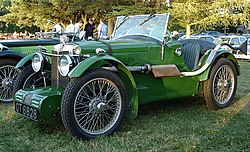MG C-Type
| MG | |
|---|---|
|
MG C-Type Midget (1931-1932)
|
|
| C-type midget | |
| Production period: | 1931-1932 |
| Class : | Sports car |
| Body versions : | Roadster |
| Engines: |
Petrol engines : 0.75 liters (32.3–38.5 kW) |
| Length: | 3327 mm |
| Width: | 1327 mm |
| Height: | |
| Wheelbase : | 2216 mm |
| Empty weight : | 732 kg |
| Previous model | MG M-Type Midget |
| successor | MG J-Type Midget |
The MG C-Type was a small sports car that MG manufactured from 1931 to 1932. It was designed for competition use and was based on its predecessor, the M-Type Midget . A special vehicle, the EX120 , was developed from the M-Type for George Eyston to try his hand at the 24-hour record in the 750 cc class in Montlhéry . This attempt was successful and so a racing replica of this vehicle was created and was called the "C-Type Midget ".
The car had a four-cylinder in-line engine with overhead camshaft (ohc) and bevel shaft, as used in the Morris Minor of 1928 and the Wolseley Ten , but with a shortened stroke, a different crankshaft and a single SU carburetor. This motor with 746 cc capacity made 44 bhp (32.3 kW) at 6400 min -1 . From 1932 there was the car with a cross-flow cylinder head, as it was later used in the J-Type . A Power Plus Compressor, the engine power of 52.4 bhp (38.5 kW) at 6,500 min -1 allowed was also available on request. The engine power was transmitted to the rear wheels via an unsynchronized four-speed gearbox. The chassis was redesigned, had the shape of a ladder with cross members made of round tube and went through under the rear axle. The suspension had semi-elliptical leaf springs and Hartford friction shock absorbers . The wire-spoke wheels with central locking hung on the two rigid axles. The car had a wheelbase of 2,057 mm and a track width of 1,067 mm.
The doorless body consisted of an ash wood frame planked with sheet steel and had a pointed boat stern for the spare wheel and steered front fenders. Later versions had a more conventional rear end and a rectangular fuel tank. The exhaust was routed along the outside of the body and ended in a spectacular fishtail. The record-breaking vehicle had a streamlined cowling over the radiator, but later cars left this cowling out as it often caused the engine to overheat at low speeds.
The production vehicle initially cost £ 295 with the naturally aspirated engine or £ 345 with the supercharged engine; at the end of production the prices were £ 490 and £ 575 respectively.
Like the Montlhéry record-breaking vehicle, the C-Type vehicles were also used in many competitions; a works team with fourteen vehicles competed in the '' Double Twelve '' in Brooklands in 1931 and took the first five places.
Web links
swell
- Green, Malcolm: MG Sports Cars , CLB International, (1997), ISBN 1-85833-606-6
- Sedgwick, Michael & Gillies, Mark: AZ of Cars of the 1930's , Bay View Books, (1989), ISBN 1-870979-38-9
- Culshaw, David & Horrobin, Peter: The Complete Catalog of British Cars 1895-1975 , Veloce Publishing plc., Dorchester (1997), ISBN 1-874105-93-6



